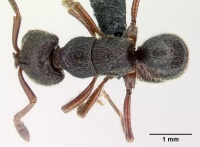Euponera antsiraka
| Euponera antsiraka | |
|---|---|

| |
| Scientific classification | |
| Kingdom: | Animalia |
| Phylum: | Arthropoda |
| Class: | Insecta |
| Order: | Hymenoptera |
| Family: | Formicidae |
| Subfamily: | Ponerinae |
| Tribe: | Ponerini |
| Genus: | Euponera |
| Species complex: | sikorae |
| Species: | E. antsiraka |
| Binomial name | |
| Euponera antsiraka (Rakotonirina & Fisher, 2013) | |
Specimens have been found mostly from leaf litter. Due to the hypogaeic habits of workers, the biology of this species is poorly understood.
Identification
Rakotonirina and Fisher (2013) - Worker: Anterior margin of clypeus medially convex or with blunt angle; posterolateral margins of propodeum and petiolar node armed with a series of sharp teeth or tubercles; head densely and finely reticulate-rugulose or reticulate-punctate behind the eye; with head in full face view, lateral borders anteriorly gradually curving towards the base of mandibles; in profile, distance between eyes and base of mandibles roughly three times or more the maximum diameter of eye; mesopleural sulcus distinctly continuous and narrowly impressed; second gastral tergite punctate, pubescence absent or reduced on first and second gastral segments.
Keys including this Species
Distribution
Euponera antsiraka is only known from the lowland and littoral forests of the central east of the Madagascar
Latitudinal Distribution Pattern
Latitudinal Range: -16.6723° to -18.0483°.
| North Temperate |
North Subtropical |
Tropical | South Subtropical |
South Temperate |
- Source: AntMaps
Distribution based on Regional Taxon Lists
Malagasy Region: Madagascar (type locality).
Distribution based on AntMaps
Distribution based on AntWeb specimens
Check data from AntWeb
Countries Occupied
| Number of countries occupied by this species based on AntWiki Regional Taxon Lists. In general, fewer countries occupied indicates a narrower range, while more countries indicates a more widespread species. |

|
Estimated Abundance
| Relative abundance based on number of AntMaps records per species (this species within the purple bar). Fewer records (to the left) indicates a less abundant/encountered species while more records (to the right) indicates more abundant/encountered species. |

|
Biology
Castes
Known only from the worker caste.
Images from AntWeb
    
| |
| Holotype of Euponera antsiraka. Worker. Specimen code casent0317590. Photographer Jean Claude Rakotonirina, uploaded by California Academy of Sciences. | Owned by CAS, San Francisco, CA, USA. |
Nomenclature
The following information is derived from Barry Bolton's Online Catalogue of the Ants of the World.
- antsiraka. Pachycondyla antsiraka Rakotonirina & Fisher, 2013: 459, figs. 26, 31, 32, 33, 71 (w.) MADAGASCAR. Combination in Euponera: Schmidt & Shattuck, 2014: 86.
Unless otherwise noted the text for the remainder of this section is reported from the publication that includes the original description.
Description
Worker
(9 specimens): HW: 1.03–1.25, HL: 1.16–1.30, CI: 88–96, SL: 0.78–0.94, SI: 74–78, PW: 0.75–0.91, WL: 1.49–1.82, NH: 0.68–0.86, NL: 0.50–0.68, NW: 0.64–0.86, DNI: 125–141, LNI: 123–143.
Head rectangular, with almost straight lateral margins which weakly converge to the base of the mandibles; posterior border more or less straight. Head capsule densely and finely reticulate-rugulose to reticulate-punctate; space between punctures about the same or smaller than diameter of puncture. Eye small, slightly protruding from the head surface, with 13 or fewer ommatidia; distance between eyes and base of mandibles roughly three times or more the maximum diameter of eye. Antennal scape short, not attaining posterior cephalic margin. Anteromedian margin of clypeus convex or bluntly angulate. Mandibular surface with widely spaced punctulae, the spaces between which are smooth and shiny; apical margins with 8–9 teeth or denticles.
In dorsal view, metanotal groove absent; dorsum of mesosoma reticulate-rugulose, interspersed with punctures; sparse tubercles may be present on anterior portion of pronotum. In profile, mesopleural suture visible as a continuous transverse sulcus from anterior margin to posterior border of mesopleuron. Posterior margin of propodeum with a sequence of teeth or denticles. In dorsal view, petiolar node punctate, lateral surface tuberculate, superimposed with punctures; in lateral view posterolateral margin of petiolar node armed with a series of sharp teeth or tubercles. First gastral segment without impression on its anterior face. First two gastral tergites with punctate sculpture.
Pilosity present on dorsum of body; pubescence sparse on first and second gastral tergites. Body color dark brown to reddish brown; appendages lighter.
Type Material
Holotype worker: Madagascar, Toamasina, FC Sandranantitra, -18.0483, 49.0917, 450 m, rainforest, sifted litter, 18–21 Jan 1999 (H.J. Ratsirarson) collection code: HJR101, specimen code: CASENT0317590 (California Academy of Sciences). Paratype: worker with same data as holotype but with specimen code HJR101(3)–21 (CASC).
References
- Rakotonirina, J.C. & Fisher, B.L. 2013. Revision of the Pachycondyla sikorae species-group (Hymenoptera: Formicidae) in Madagascar. Zootaxa 3683, 447-485.
- Schmidt, C.A. & Shattuck, S.O. 2014. The higher classification of the ant subfamily Ponerinae (Hymenoptera: Formicidae), with a review of ponerine ecology and behavior. Zootaxa 3817, 1–242 (doi:10.11646/zootaxa.3817.1.1).
References based on Global Ant Biodiversity Informatics
- Rakotonirina J. C., and B. L. Fisher. 2013. Revision of the Pachycondyla sikorae species-group (Hymenoptera: Formicidae) in Madagascar. Zootaxa 3683 (4): 447-485.

